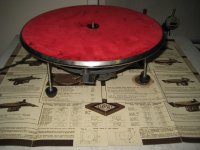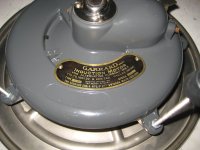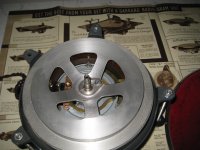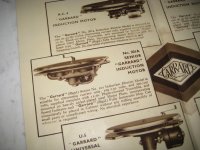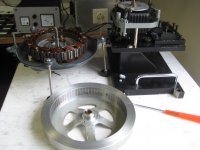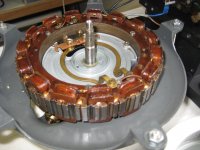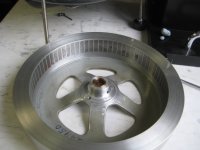Amazing stuff jcarr. Never new about TEAC. Thanks very much.
If bearing is in oil and we use magnetic suspension inside the bearing assembly. Wouldn't it be some what firm to worry about spring effect. As I said it took quite an effort to pull out spindle from Pioneer bushing due to vacuum it created. If somehow one manages to couple the tonearm base to bearing assembly above the magnetic suspension and with the platter, tonearm and platter movements will be in sync.
Forgot the model no. but NAD also had some innovative designs. FONS CQ30 looks like another good turntable. Suspension is like linn. Don't know about motor. Rumble figures are quite good. Don't know how they achieved it.
Regards
If bearing is in oil and we use magnetic suspension inside the bearing assembly. Wouldn't it be some what firm to worry about spring effect. As I said it took quite an effort to pull out spindle from Pioneer bushing due to vacuum it created. If somehow one manages to couple the tonearm base to bearing assembly above the magnetic suspension and with the platter, tonearm and platter movements will be in sync.
Forgot the model no. but NAD also had some innovative designs. FONS CQ30 looks like another good turntable. Suspension is like linn. Don't know about motor. Rumble figures are quite good. Don't know how they achieved it.
Regards
Hiten: magnetic levitation inside the bearing assembly may not have been practical in the 1950s and 1960s. But today, powerful neodymium and samarium cobalt magnets are readily available. IME, partial levitation has less restricted dynamics (particularly in the lower octaves) and a better sense of foundation to the music, but there is no doubt that the noise floor is quieter with full levitation. If that is what attracts you, you definitely should give full magnetic levitation a try.
Here is a lengthy thread on magnetic levitation bearings for turntable use. Good reading!
http://www.diyaudio.com/forums/analogue-source/96655-magnetic-turntable-bearing.html
Here is a lengthy thread on magnetic levitation bearings for turntable use. Good reading!
http://www.diyaudio.com/forums/analogue-source/96655-magnetic-turntable-bearing.html
Hitan. Thanks for mentioning Fon CQ30. I had forgotten that one. As important as it was I never saw one. Fergus Fons I think was his name. One more to add to the Linn story.
As you say the oil is part of the bearing question, listen for the same effects as the magnetic levitation. The ERA I owned had an inverted bearing. It was almost impossible for it to retain oil except in the phosphor-bronze. By constantly giving it a drop of oil it seemed happy and sounded better. If I had one now I would build it an oil reservoir that almost touched the sub platter bottom, a cap from an aerosol perhaps ( not too wide ). The ERA platter looked heavier than it was. This didn't seem to have a negative effect. In fact it was quite good.
When looking for ERA they had given up as the French government had given them a contract for military parts. £20 000 for a set of worn out machine tools and drawings was of no interest. £200 000 now. I seem to remember Verdier worked with them from his writings.
As you say the oil is part of the bearing question, listen for the same effects as the magnetic levitation. The ERA I owned had an inverted bearing. It was almost impossible for it to retain oil except in the phosphor-bronze. By constantly giving it a drop of oil it seemed happy and sounded better. If I had one now I would build it an oil reservoir that almost touched the sub platter bottom, a cap from an aerosol perhaps ( not too wide ). The ERA platter looked heavier than it was. This didn't seem to have a negative effect. In fact it was quite good.
When looking for ERA they had given up as the French government had given them a contract for military parts. £20 000 for a set of worn out machine tools and drawings was of no interest. £200 000 now. I seem to remember Verdier worked with them from his writings.
This is in French. Many pictures to look at.
Ralisation d'une platine de trs haute qualit, Verdier -1-
Ralisation d'une platine de trs haute qualit, Verdier -1-
Douglas Self wrote to me about an air compressor amplifier that was set up aloft on the Eiffel Tower. Said to have the loudest rumble ever. The second link is just a lovely piece of engineering.
Donald Aldous on retiring aged 90 said the bass quality of these air compressor turntables was in some ways the best he ever heard. A real gentleman. The young man from Meridian at a show asked the 89 year old what he thought of the new active speakers and gave him the model numbers. Finally he asked the professor of audio what he thought? " Very nice except I think you will find it is an M2 on the left and M3 on the right. Apart from that it was very good. " I was there, it was so gently said.
Trying to find out all the details of the Garrard 201. Daft really as I have looked at both. The pre 1939 and LP version. Dating to 1928, direct drive with some resemblance to the turntable in the YouTube link mechanically. It continued up to 1954 running alongside the 301 for a few months. I think I saw one used as a potters wheel. It had a felt device that needs oil. If allowed to run dry the turntable could burst into flames. Like most of these stories it probably means it got hot.
The Auxetophone.
https://www.youtube.com/watch?v=Q96gqa2Ds9w
Donald Aldous on retiring aged 90 said the bass quality of these air compressor turntables was in some ways the best he ever heard. A real gentleman. The young man from Meridian at a show asked the 89 year old what he thought of the new active speakers and gave him the model numbers. Finally he asked the professor of audio what he thought? " Very nice except I think you will find it is an M2 on the left and M3 on the right. Apart from that it was very good. " I was there, it was so gently said.
Trying to find out all the details of the Garrard 201. Daft really as I have looked at both. The pre 1939 and LP version. Dating to 1928, direct drive with some resemblance to the turntable in the YouTube link mechanically. It continued up to 1954 running alongside the 301 for a few months. I think I saw one used as a potters wheel. It had a felt device that needs oil. If allowed to run dry the turntable could burst into flames. Like most of these stories it probably means it got hot.
The Auxetophone.
https://www.youtube.com/watch?v=Q96gqa2Ds9w
How many poles ? I was told 36 but never verified it. It has a 1928 patent and said BBC took some in 1932. Loricraft has one like yours and 1950's three speed.
jcarr, good to see actual implementation in the mentioned thread. Have read first few pages. The Auxetophone is indeed unique. Thanks everyone for inputs.
In auxetophone wonder how quick would be grid valve responding ? chucklesome if we make it analogus to slew rates of modern amplifier. But it still sounds ok. Victor Auxetophone.
Lencos have good following. Contrary to horizontal idler wheels where a slight movement on axis will not result in any speed changes, vertical idlers if there is a play where idlers is held or at rod which moves idler on the tapered motor shaft, negligible possibility of speed change is there. Not sure as have never seen it in action. Ideally wouldn't it have more stability if idler is very well fixed in single place and motor moved below it ? One can use two idlers so motor will require less excursion. Probably earliest example of vertical idler is scott 710. U.S.A. made and shown more than halfway in following link. WiredState Audio Community • View topic - ANALOG GALLERY - LENCO L-75 TRIPLE ARM Where three idlers are used and it seems are fixed.
Regards
In auxetophone wonder how quick would be grid valve responding ? chucklesome if we make it analogus to slew rates of modern amplifier. But it still sounds ok. Victor Auxetophone.
Lencos have good following. Contrary to horizontal idler wheels where a slight movement on axis will not result in any speed changes, vertical idlers if there is a play where idlers is held or at rod which moves idler on the tapered motor shaft, negligible possibility of speed change is there. Not sure as have never seen it in action. Ideally wouldn't it have more stability if idler is very well fixed in single place and motor moved below it ? One can use two idlers so motor will require less excursion. Probably earliest example of vertical idler is scott 710. U.S.A. made and shown more than halfway in following link. WiredState Audio Community • View topic - ANALOG GALLERY - LENCO L-75 TRIPLE ARM Where three idlers are used and it seems are fixed.
Regards
Two birds with one stone. That's what a pickup arm should look like. It will eat many for breakfast.
https://www.youtube.com/watch?v=9vuDMInQMYQ
https://www.youtube.com/watch?v=9vuDMInQMYQ
These looks like 16" turntables. BBC Workshop. Any idea what are they ? Two are with linear tonearms I think.
Regards.
Regards.
I recognize them but can't put a name to them.
16 inch is a common requirement for record cleaning machines ( ! ). By pure accident the Loricraft PRC machines are OK to do that, it meant raising the platter by about 2mm. The 16 inch disc clears the arm by about 5 mm. They have a PRC 5 for 20 inch .
16 inch is a common requirement for record cleaning machines ( ! ). By pure accident the Loricraft PRC machines are OK to do that, it meant raising the platter by about 2mm. The 16 inch disc clears the arm by about 5 mm. They have a PRC 5 for 20 inch .
The ones on the left looks to be a version of Goldring GL58 with other make of arm. The parallel tracker is a BBC own design also fitted to 301's. Source of this info Terry O'Sullivan Loricraft Audio.
Thank you sir. Contribution to high fidelity by BBC could be a subject of its own. Found an archives. BBC equipment. Amazing stuff. There is a section for cuegrams at the bottom.
One interesting TT motor is from Dual. It had a bush type pulley with rod inside. Which can be moved inside to change speed. Dual Motor.
Pioneer PL-41. A japanese idler with Hysteresis motor and has tubes to deliver oil to the bushes. Pioneer pl-41
Regards
One interesting TT motor is from Dual. It had a bush type pulley with rod inside. Which can be moved inside to change speed. Dual Motor.
Pioneer PL-41. A japanese idler with Hysteresis motor and has tubes to deliver oil to the bushes. Pioneer pl-41
Regards
- Status
- Not open for further replies.
- Home
- Source & Line
- Analogue Source
- Interesting turntables.
